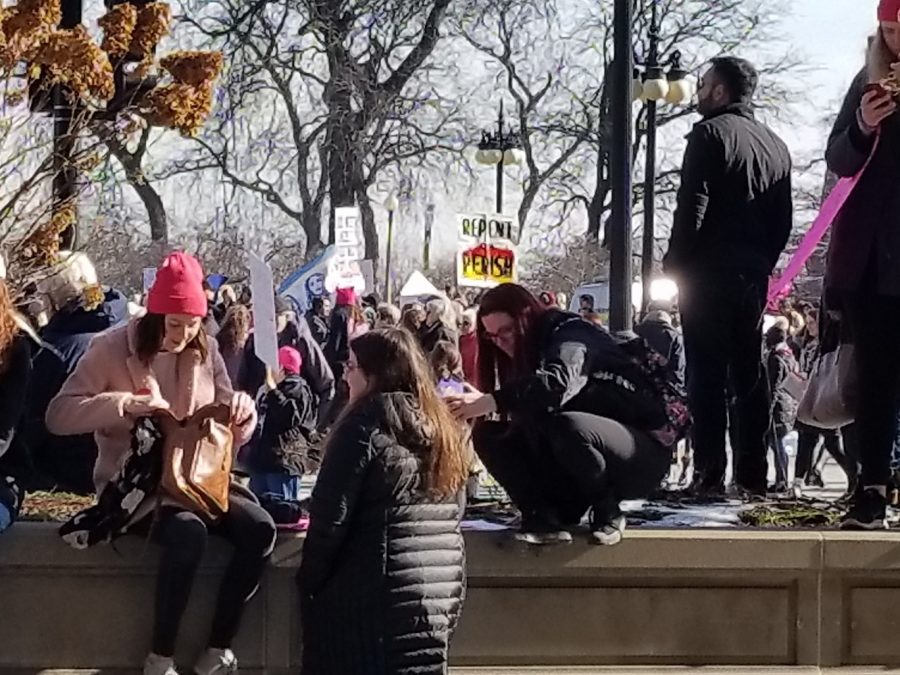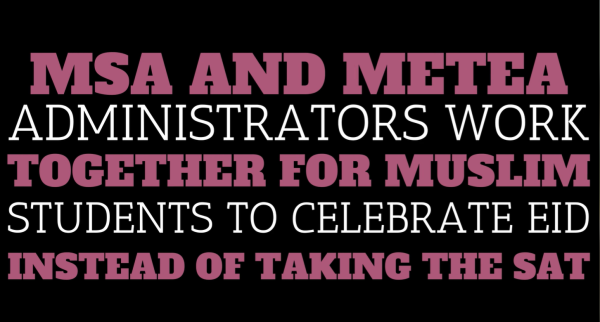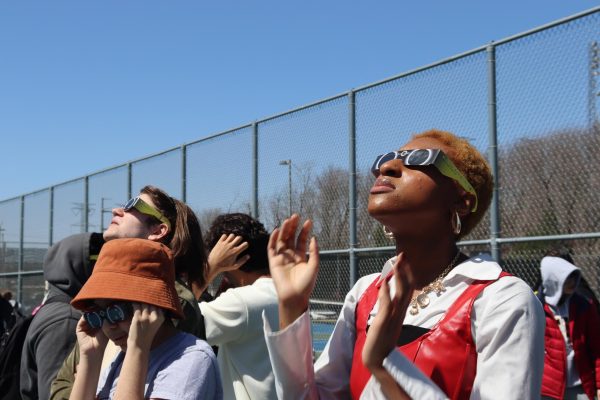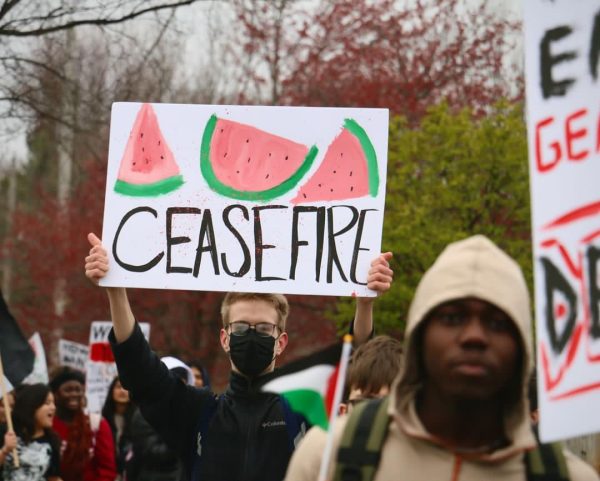Students plan walk out protest for student voice
Student Government is coordinating a walkout on March 14 during fourth period from 9:53 to 10:30. It will feature a small march, a few student speakers, and a musical performance. The event is still entirely optional for all students, so the school day will continue as normal for those who decide not to walk out. Student voice is an important point in today’s political and social climate. The young people in Parkland, Florida have shown how important the words of the younger generation can be for our national discourse. In light of that power, students in our district are putting together a protest to empower students.
“We want to make sure we’re getting our message across that this is about student voice, so we want to make sure that students are protesting in whatever way they see fit,” Student Government member Jyostna Balmuri said. T-shirts will be sold in the Commons, there will be the signing of a #IAmWalkingOutBecasue banner that lists reasons for students walking out, letter writing stations for students to write to local and state legislators, as well as poster making sessions for the event before and after school and during lunches during the week preceding the event.
“This is a choice. I might add. Those who do not choose to participate will stay in their classrooms and the teacher will continue teaching unless all of the students in the classroom decide to participate,” Student Government member Alexa Jordan said.
Students interested in participating should be aware of the restrictions on any form of protest on school grounds. While normally walking out of school results in disciplinary action, students participating in the walkout will be allowed to do so on this occasion. Those missing class are still responsible for work they miss. “It’s a choice that kids are making. That choice means that they are willing to miss class and suffer the consequences of needing to make up stuff that they miss, in that case, the school can respect that,” Social Studies chair and Student Government sponsor Donald Pankuch said.
Student rights to protest have been a critical issue in the United States for many years. When Mary Beth Tinker wore an armband to protest the Vietnam war at her junior high, she took her district to court over their attempt at punishing her for speaking out. The case, Tinker v Des Moines, ended in a 7-2 decision. The supreme court held that because the protest was passive, did not interfere with the learning process, and because students do not lose their first amendment rights in public schools, the protest was legal and unpunishable.
Students are allowed to exercise their first amendment rights in public schools so long as their protest is not disruptive to the learning process. That means that students are allowed to wear pro-NRA shirts or put women’s rights pins on their backpack, for example, so long as in doing so they do not interrupt the learning environment.
While administrations can interpret the ambiguity of ‘disruptive to the school environment’, there is supreme court precedent for what does constitute a disruption.
In Morse v Frederick, Joseph Frederick sued his principal for giving him an unlawful suspension for holding a banner reading “Bong Hits 4 Jesus” at a school event. The supreme court took the case, coming to the decision that while Frederick should retain his rights to political protest under the first amendment in public school, this did not extend to pro-drug references at school events: that was deemed a disruption of the school environment.
For students interested in making their voice heard, these court cases establish a powerful precedent and provide a guideline in which to do so correctly. The administration is within their rights to punish students for disrupting the classroom environment in any way, including protest signs depicting weapons or supporting illegal drug use.
The walkout is meant to encourage student voice and promote unity within the district. Across the district, there are varying and diverse opinions, but the protest is not there to isolate or alienate. “All three schools tried to come up with a mission for the walkout, and the best we could get to was that students want change,” Pankuch added.

Avani Shah is a senior and Headlines Editor for Metea Media. This is her second year on staff. Avani is a black belt in Tang Soo Do. She can often be found...













Revive • Mar 12, 2018 at 3:52 pm
” Morse v Frederick, 551US 393(2007).
Mary • Mar 8, 2018 at 12:31 pm
And how is this helping the problem? Present solutions, not standing outside and leaving a classroom.. that does.. nothing.
darkstripe • Mar 9, 2018 at 9:34 am
our government isn’t doing anything, that’s the issue. nothing was done for columbine, nothing was done for sandy hook, nothing ever changes. the goal of this walk-out is to point it out so the government will bend under pressure and people will be aware that our gov isn’t doing anything to stop it. after all, there is nothing more terrifying to the older generations currently running our government than the newest ones.
Mary • Mar 9, 2018 at 12:18 pm
Come on now, school shootings aren’t a common thing. You have more of a chance dying from a car crash, medical malpractice, accidental drowning, and many other things. Why are people focusing on a small fraction, first focus on bigger fractions. This is an issue, but it’s not common. It’s extraordinarily rare. What are people accomplishing by skipping a class period? Nothing. Instead, propose solution and make your group look educated and intelligent, not like a bunch of high school students skipping a class to show “awareness”. I’m sorry, but it doesn’t paint a pretty picture.
darkstripe • Mar 9, 2018 at 1:50 pm
i’ve said it before and i will say it again: just because it doesn’t happen commonly doesn’t mean it shouldn’t be focused on. on top of that, look: those things you mentioned as being more common happen all over the world, and people try as much as they can to stop them. when a mass shooting happens, america does nothing. look at australia. they haven’t had a single mass shooting since 1996. why? gun control. that’s our goal here: gun control. people like the parkland shooter shouldn’t have these dangerous weapons in the first place. we need a better gun control system.
so you may say we don’t have a mission: the mission is gun control and prompting the people running this country on the capitol hill to do something about it.
Someone Educated • Apr 3, 2018 at 10:16 am
Has anyone noticed that this darkstripe kid can’t reply back with any logical information but always likes to reference Australia, sorry this is America buddy not Australia. Have you read the second amendment “Shall not be infringed” Do you know what that means? Most the anti-gun comments are not looking into the negative side of taking the ability for law abiding citizens to legally own a firearm, criminals don’t care about laws, that’s what the definition of a criminal is. There are black markets for everything and always will be. Taking guns away will only create more crime.
SlurpySoup • Mar 13, 2018 at 6:15 pm
12-30,000 deaths per year due to firearms (including suicides) are nothing when compared to 500,000-3 million saved through the legal usage of firearms in America. There would be a crime epidemic in America if there was gun control. Bad people would attain guns illegally, while law abiding citizens will have to rely on the cop that is 10-15 minutes away at the time of a violent crime. People are inherently evil, and no amount of gun laws can prevent that. Just look at South America and the cartel crisis. They have stricter gun laws yet see much more gun violence.
mm • Mar 8, 2018 at 11:17 am
I think that we should arm our teachers because that will make our classrooms safer. If somebody had two options to shoot up a school, and one school has a gun free sticker in the window and the other says “Our teachers have been trained and are armed with firearms” which would you the potential shooter go to? Would they really shoot up a school that isn’t sitting ducks and are willing to defend themselves and their kids at all costs, unlike our current school system where we are told to just “hold in place” aka be sitting ducks?
Ryan • Mar 8, 2018 at 1:55 pm
You do realize a kid could just steal the weapon right? I think all schools should teach kids how to disarm and eliminate a threat
Blitz • Mar 9, 2018 at 7:26 am
That would be a problem. “Disarm and eliminate” the shooter pretty much means “suicide mission.” You have a gun, you see someone running towards you to stop you. What would you do? In any situation, you would fire.
darkstripe • Mar 9, 2018 at 9:32 am
i mean the kids or unstable staff workers could just steal the guns from the teachers, and on top of that the “give teachers guns” idea assumes that there’s a 100% certainty that teachers will never snap and turn the gun on innocent children, and then on top of all of this, but ok
Mr. Man • Mar 12, 2018 at 8:11 am
Bro my teachers can’t even keep track of their classroom keys LMAO. I’m not about to trust them with firearms.
Blitz • Mar 14, 2018 at 7:30 am
That too, hahah. And trust me, kids these days will steal anything and everything if they have a chance. Doesn’t matter if it’s of value or not. They see it, they think it’s cool, they swipe it. Happened to me far too many times. That’s why I don’t leave anything out anywhere. Paranoia. I can’t even leave something on the seat of my car without being as paranoid as an asylum resident.
SlurpySoup • Mar 13, 2018 at 6:03 pm
Agreed.
MOMS AGAINST VAPING • Mar 8, 2018 at 8:15 am
I would like to form a march against e-ciggarets
Blitz • Mar 8, 2018 at 8:12 am
I always say “I have the responsibility of an adult and the freedom of a toddler.” Interpret that how you will. How you read it is probably true. I just feel like I’m also never heard for anything. Either because I talk very quietly or no one cares to listen. Probably both. Definitely both. Volume regulation is difficult for me. I feel like I’m talking normally and people either say “, stop yelling!” or “Speak up , you’re too quiet.” Or nothing. They usually say nothing. I’m used to it.
Abby • Mar 8, 2018 at 10:26 am
Me too
Killian Kenny • Mar 8, 2018 at 7:42 am
My only concern is if it will hamper my education. I don’t want to miss on a potentially important lesson.
Blitz • Mar 9, 2018 at 7:23 am
Like the article said, this is completely optional. Students who will march will leave, students who don’t will stay.
protester • Mar 8, 2018 at 7:33 am
I’d like to thank you for writing this article. My parents have been wary about the subject, and while I was going to participate no matter what the cause, it’s nice to have all of the information in one place to comfort my parent’s worries about me walking out of school.
This is not a matter of the 2nd amendment. This is a matter of the safety of not only our generation, but future generations to come. The fight doesn’t end in a day, it will never end until our schools across the nation are safe.
Personally, I believe assault rifles and similar weapons especially should be the most difficult to get, without going through deep background checks and being at least the age of 21. The idea that someone in the grade above mine can buy an extremely lethal weapon is bone chilling.
In no way is anyone truly trying to “ban guns.” Thoughts and prayers do nothing. We as a student body need change, and we need it now.
axiet • Mar 8, 2018 at 10:47 am
I think more security would be better.
High school is a cesspool of hormonal teenagers.
DM • Mar 8, 2018 at 11:35 am
I completely agree. It is nice to have someone feel the same way as me.
a • Mar 8, 2018 at 3:30 pm
Brohammer, assault rifles are already illegal. AR in AR-15 doesn’t stand for assault rifle, it stands for Armalite, the company that originally designed the gun.
darkstripe • Mar 9, 2018 at 9:25 am
completely agree with this post right here. good post op
SlurpySoup • Mar 13, 2018 at 6:01 pm
There was already an assault rifles ban in 1986. You can not legally own one. Handguns are just as lethal as AR 15s and taking away semi-automatic firearms (which includes ARs, Handguns, Shotguns) would be a restriction of the fundamental right to bear arms and protect yourself.
sebastian • Mar 8, 2018 at 7:29 am
what the dab bro i’m totally gonna do this.
Laura • Mar 7, 2018 at 5:42 pm
Great article. Just wanted to let you know there is a typo in your hashtag.
Lauren • Mar 7, 2018 at 1:54 pm
I really want to participate but if I do then i have to reschedule my debate in english
Danny Lee • Mar 7, 2018 at 1:31 pm
do i just walk out of my classroom and go to the front desk and tell them that i am walking out?
nice • Mar 8, 2018 at 12:31 pm
You do it secretly so they don’t know
Nikki C • Mar 13, 2018 at 7:50 am
You drop your backpack at your 4th period class and tell your teacher you are walking out and then walk out the front entrance towards the flagpole.